#Andalusian cuisine
Explore tagged Tumblr posts
Text
Discover Andalucía: A Journey Through Spain's Vibrant Region
Discover Andalucía: A Journey Through Spain’s Vibrant Region Andalucía, the southernmost region of Spain, captivates visitors with its rich history, diverse culture, and stunning landscapes. From the majestic Alhambra in Granada to the vibrant streets of Seville, Andalucía offers a perfect blend of tradition and modernity. Join us on an unforgettable journey through this enchanting…

View On WordPress
#Alhambra#Andalucía#Andalusian cuisine#Costa del Sol#Cultural Experiences#Flamenco#Seville#Spain#travel destinations#white villages
0 notes
Text
Spanish Gazpacho: Cool and Refreshing Summer Soup

When the summer season sunlight blazes, there is absolutely nothing fairly such as a cooled dish of Spanish Gazpacho to freshen your palate. This timeless Spanish recipe uses a fascinating mix of fresh veggies as well as tastes, production it the best selection for warm summer season days. In this write-up, we will look into the world of Gazpacho, discovering its background, active ingredients, prep work, as well as why it is a precious summer season favored.
The Background of Gazpacho
Gazpacho has actually a fabled background that traces its beginnings to the Andalusian area of Spain. This cool soup days back centuries as well as was initially a peasant recipe. Farmers would certainly utilize the wealth of summer season veggies to develop a basic yet beneficial dish. Gradually, Gazpacho progressed right into a cooking work of art, precious not just in Spain yet additionally around the globe.
The Active ingredients
The magic of Gazpacho exists in its fresh as well as wholesome active ingredients:
Tomatoes: Ripe, juicy tomatoes are the celebrity of the reveal, supplying a pleasant as well as tasty base for the soup.
Cucumbers: Amazing as well as crisp cucumbers include a revitalizing crisis to the Gazpacho.
Bell Peppers: Lively as well as vivid bell peppers add sweet taste as well as deepness of taste.
Onions: Onions supply a tip of intensity as well as intricacy to the soup.
Garlic: A touch of garlic infuses the Gazpacho with a fascinating pungency.
Bread: Stagnant bread is made use of to enlarge the soup as well as include body to the appearance.
Olive Oil as well as Vinegar: Premium added virgin olive oil as well as vinegar are vital for boosting the total preference.
The Prep work
Developing Gazpacho is an uncomplicated yet artful procedure. The veggies are carefully cut as well as combined along with the bread, developing a smooth as well as velvety appearance. Olive oil as well as vinegar are included to stabilize the tastes. The soup is after that cooled, permitting the active ingredients to meld as well as the tastes to intensify. In the past offering, it is garnished with fresh natural herbs, croutons, or diced veggies for an added ruptured of shade as well as preference.
Why Gazpacho?
Gazpacho's appeal transcends boundaries as a result of its simpleness as well as adaptability. It is a revitalizing as well as nourishing alternative for those looking for reprieve from the summer season warmth. The mix of ripe tomatoes as well as crisp veggies develops a unified stabilize of tastes that dancings on the taste. Whether took pleasure in as an appetiser or a light dish, Gazpacho is a party of summer's bounty.
Verdict
In the world of summer season recipes, Spanish Gazpacho rules as a classic favored. Its background, fresh active ingredients, as well as uncomplicated prep work make it a recipe that records the significance of Spanish food as well as the spirit of summer season. Whether relished on a balcony in Seville or made in your personal cooking area, Gazpacho is an invite to welcome the amazing as well as freshening tastes of Spain throughout the best months of the year.
tags : Gazpacho, Spanish soup, Chilled soup
#Gazpacho#Spanish soup#Chilled soup#Summer recipe#Andalusian cuisine#Cold tomato soup#Refreshing summer dish#Gazpacho history#Ingredients for Gazpacho#Spanish culinary tradition#Tomato-based soup#Summer refreshment#Mediterranean flavors#Gazpacho preparation#Spanish gastronomy
0 notes
Text
Seville's Heartbeat (Pablo Gavi.)
Summary: Gavi proudly introduces his girlfriend, Y/N, to Seville's rich culture through historic landmarks, local cuisine, and flamenco. Their journey culminates at the Feria de Abril, where Y/N joins in the festivities, deepening their bond and beginning their shared exploration of Seville's traditions.


Gavi had always been proud of his hometown, Seville, with its rich history and vibrant culture.
When he met Y/N, his foreign girlfriend, he couldn't wait to show her everything that made Seville special.
One sunny morning, Gavi took Y/N on a stroll through the narrow, cobblestone streets of the old town. The air was filled with the scent of orange blossoms as they passed by centuries-old buildings adorned with intricate Moorish architecture.
"This is the Real Alcázar," Gavi explained, pointing to the majestic palace ahead.
"It's a UNESCO World Heritage site, and the gardens are absolutely stunning."
Y/N was captivated by the beauty of the palace and its lush gardens, where peacocks roamed freely among the fountains and orange trees.
She took countless photos, wanting to remember every detail.
As they continued their walk, they stumbled upon a bustling market in Plaza del Salvador.
The aroma of freshly baked bread and grilled meats wafted through the air, tempting them to sample traditional Andalusian delicacies.
"This is where locals come to shop for fresh produce and enjoy tapas," Gavi said, ordering a plate of jamón ibérico and manchego cheese for them to share. Y/N savored the flavors, delighted by the authenticity of the food.
In the evening, Gavi surprised Y/N with tickets to a flamenco show at a small, intimate tablao.
The passionate music and intricate dance moves left Y/N spellbound, her heart racing with the rhythm of the castanets.
"This is flamenco," Gavi whispered, his eyes fixed on the stage.
"It's more than just a dance; it's a way of expressing emotions and telling stories."
Y/N nodded, understanding the intensity and passion behind the performance. She could feel the energy reverberating through the room, connecting her to centuries of Andalusian culture.
On their final day together, Gavi took Y/N to experience the Feria de Abril, Seville's famous spring fair.
The fairgrounds were alive with color, filled with hundreds of casetas (decorated tents) where families gathered to eat, drink, and dance sevillanas.
"This is our most cherished tradition," Gavi said, leading Y/N into a caseta where his friends and family awaited them.
They were welcomed warmly, and Y/N was introduced to everyone as Gavi's girlfriend from abroad.
Throughout the day, they indulged in traditional dishes like paella and churros, and Y/N even tried on a colorful flamenco dress, joining in the dancing with newfound friends.
As the sun set over the fairgrounds, Gavi and Y/N sat together, savoring the moment.
"Thank you for sharing all of this with me," Y/N said, leaning against Gavi's shoulder.
Gavi smiled, knowing that he had given Y/N a glimpse into the heart and soul of Seville.
"There's so much more to explore," he said softly, his hand finding hers.
And as they watched fireworks light up the night sky, they knew that their adventure together was only just beginning.
#pablogavi#gavi x reader#pablo gavi#fc barcelona#footboller imagine#pablo gavi imagine#gavi imagine#pablo gavi fluff
133 notes
·
View notes
Text
The Lost Tastes of Medieval Andalusian Cuisine: A Wealth of Spices and Flavours
Here is a list of some of these lost tastes, which reflect the richness of medieval Andalusian cuisine.
23 notes
·
View notes
Text

El precio del turismo de masas - La tienda los 8 caños, Ronda, 2016.
Ronda, the legendary cradle of Spanish style bullfighting, has been a tourist attraction for a very long time. Among others writing in English, Richard Ford in his rather ill-tempered Handbook for Travellers in Spain (1832) describes how to make a visit. Prosper Méremée based his work from which the opera Carmen was derived on a stay at about the same time.
I first visited the town almost a half century ago when it had only a smattering of tourist centric activity. Now it is on the mass tourism circuit. Cruise ships docking in Málaga or even Cádiz offer excursions for their passengers, and it is on most tour operators' Andalusian itineraries. Many of Ronda's old town buildings are now used to vend tourist services and treasures. Restaurants on the cliff for which the town is famous offer menus in English and usually also in German and French. On my 2016 visit I mistakenly stopped for lunch at one where there was no written menu in Castellano as few Spanish speakers went there. The cuisine on offer is usually generic with no authentic cocina andaluza but rather those dishes associated with Spain by tourists (tapas, typical of central Spain or paella, a Valencian dish for example - reminiscent of ordering Boston baked beans in New Orleans or shrimp and grits in Seattle).
If one is a bullfighting aficionado or just wants to see a corrida for the experience, Ronda's historic bull ring remains the place to do so. Tourists are mostly fascinated with the building and its history not with the bloody spectacle itself. Tour busses usually do not stay long enough for day trippers to be herded in to see a corrida, and thus most of those in the audience are not t-shirt tourists. If you should go, remember to get a sombra seat, a little more expensive, as the afternoon sun can be quite hot, and its glare can be a problem.
Waiting for the corrida to begin, look for a snack shop offering bocadillos y bebidas rather than sandwiches and drinks.
12 notes
·
View notes
Text
7th part of the bookscans of Al Andalus. Historical Figures, here's the previous part
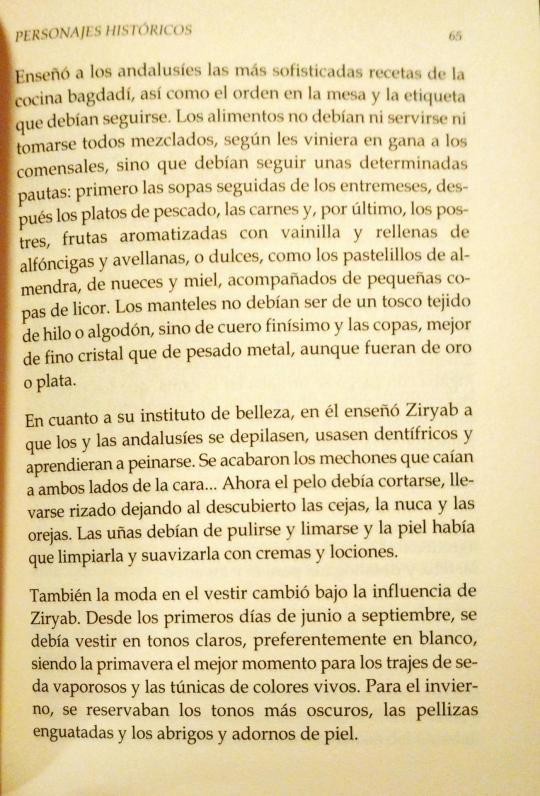
He taught the Andalusians the most sophisticated recipes of Baghdad cuisine, as well as the order at the table and the etiquette that had to be followed. The food should not even served or taken all mixed, as the diners wanted, but they had to follow certain guidelines: first the soups followed by the hors d'oeuvres, then the fish dishes, the meats and, finally, the desserts, fruits flavored with vanilla and stuffed with alphoncigas and hazelnuts, or sweets, such as almond, walnut and honey pastries, accompanied by small glasses of liquor. The tablecloths should not be of a coarse woven linen or cotton,nbut of very fine leather and the cups, better of fine crystal than of heavy metal, even if they were gold or silver.
As for his beauty institute, Ziryab taught the Andalusian to shave their hair, use toothpaste and to comb their hair. The strands that fell on both sides of the face ended... Now the hair had to be cut, worn curly, revealing the eyebrows, the nape of the neck and the ears. Nails should be polished and filed and the skin had to be cleaned and softened with creams and lotions.
Fashion in clothing also changed under the influence of Ziryab. Since the first days from June to September, they had to dress in light colors, preferably in white, spring being the best time for suits of gauzy silk and brightly colored tunics. For winter, they reserved the darker tones, the quilted pelisses and the fur coats and decorations.

Everyone asked him for advice when it came to dressing, fitting shoes, giving a banquet... and everyone followed his instructions fully. It became a real arbiter of elegance and under his influence, the Andalusians, and also the Christians, changed their clothes, their furniture, their fashions and ways of living, their kitchen and their etiquette. No one did more to spread refinement and elegance of the Abbasid court, nor did he influence in a more profound and intense way than this singer arrived from Baghdad and maintained by the munificence of the Emir of Córdoba.
Also attributed to him, imported from Persia, are many customs and superstitions that still exist among us and that are too known, such as the fear of cravings in pregnant women, the belief thatbthe boy who played with fire wet the bed, the tails of raisin increase memory... It is believed that both the game of polo and the game of chess entered Muslim Spain at the hands of Ziryab.
He never felt tempted by power, despite the much premedication that he had in Andalusian society, nor did he take part in the frequent and dark courtesans intrigues, and he always thanked the emir for providing him with a better, calm, happy and comfortable life for him and his people.

Tarub: the favorite of Abd al-Rahman II
All historians recognize that this emir was a complete womanizer. The young virgins, arriving from all corners, populated the harem of this man, so different from his father, the strict al-Hakam, who had bequeathed him a kingdom almost pacified, with the Treasury coffers filled to overflowing, which allowed him dedicate to all the pleasures that life can offer. Of his many concubines, wives and favorites, there was one whom it seems he loved more than all the others, Tarub, whose success with the caliph was perhaps due to her being surly, selfish and desired.
She must have been very beautiful, at least in the eyes of the enamored emir who, a man of great education and good poet, said of her: "Whenever I see the sun rise that illuminates reminds me of Tarub, a girl adorned with the trappings of beauty: "The eye that contemplates it believes it sees a beautiful gazelle in it".
When he was not on an expedition, Abd al-Rahman II, like all sovereigns and nobles of the era, went hunting, to the mountains of Sierra Morena or to the marshes of the Guadal-

quivir... but more than once, the memory of Tarub made him return to the palace, eager to possess that beauty who did not always respond to his amorous requirements.
Life inside that immense harem it couldn't have been easy for the women locked up there no matter how generous the emir had been or was towards them. There is no need to forget that for another of his favorites, al-Shifa, as beautiful as prudent and pious, Abd al-Rahman bought a mythical jewel, the dragon necklace, which had belonged to the wife of the caliph Harun al-Rashid, and that it came from the robbery and looting of the badgadi palaces during the period of the civil struggles that preceded the accession to the throne of the caliph al-Ma'mun. But many times, the jewels and riches that these women accumulated did not make up for the feeling of feeling relegated, supplanted in the affection or whim of the emir, by others younger and perhaps more beautiful.
Surrounded and guarded by a legion of eunuchs, who were the only ones who could move freely through that place, their whole dream was to be able to give a male child to their lord, with which they became umm walad, that is, "princess mother." These lucky ones enjoyed great privileges. To the death of the emir were emancipated and could freely dispose of her personal fortune that used to be very large. But with or without a child, the ambitious heart of Tarub wanted to “make a future for herself.” The princesses mothers, as the years went by, saw themselves replaced in the prime of life, with an intact beauty that time had not yet withered. Tarub knew it and despite
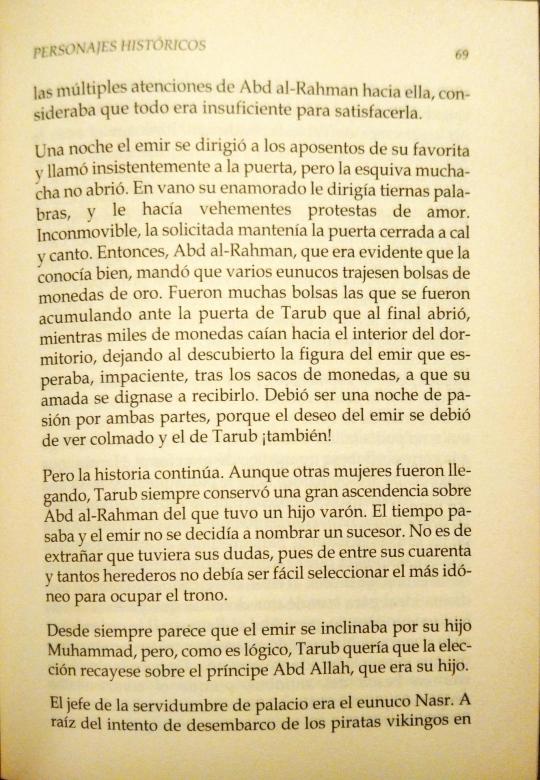
Abd al-Rahman's multiple attentions towards her, she considered that everything was insufficient to satisfy it.
One night the emir went to his favorite's chambers and called insistently at the door, but the elusive girl did not open it. In vain her lover spoke tender words to her, and made vehement protests of love. Unmovable, the requested one kept the door firmly closed. Then Abd al-Rahman, who clearly knew her well, ordered that several eunuchs carried bags of gold coins. There were many bags that were accumulating before the gate of Tarub that he finally opened, while thousands of coins fell into the bedroom, exposing the figure of the emir who waited, impatiently, behind the bags of coins, for his beloved would deign to receive him. It must have been a night of passion for both of us. parts, because the emir's wish must have been fulfilled and Tarub's too!
But the story continues. Although other women arrived, Tarub always retained a great ancestry over Abd al-Rahman from whom he had a son. Time passed and the emir could not decide to name a successor. It is not surprising that he had his doubts, since among his forty heirs it couldn't be easy to select the most suitable one to occupy the throne.
It always seems that the emir was inclined towards his son Muhammad, but, of course, Tarub wanted the choice to fall to Prince Abd Allah, who was her son.
The head of the palace servants was the eunuch Nasr. Following the attempt to landing of the viking pirates in

al-Andalus, Nasr had distinguished himself by his heroic behavior and by having defeated them in the battle that took place near Tablada. All this did that the emir appreciated him in a special way and that his influence at court was increasingly greater. Nasr and Tarub got along very well, they were both ambitious, and the princess mother, desperate to see her son named successor decided, with the support of the eunuch, to plot a plot, quite sinister indeed, to ensure the much-desired succession to his son Abd Allah. The plot involved poisoning the prince who was presumed to be possible heir, Muhammad,... and by the way, and just in case the fact aroused suspicion, also ending the father, that is, the emir.
It was a very risky plan for Tarub but she was sure that with the complicity of Nasr, one of the strongest men at court and, possibly the closest to the emir, she could not fail. And it happened that, in those days, a very famous doctor, Harrán, arrived at the Cordoban court, who came from Mesopotamia. Nasr asked him to prepare a drink poisoned and the doctor did not dare to deny him. Afterwards, he felt remorse and confessed the plot to another of the princess mothers, Farj, who informed the emir of the conspiracy that was being hatched against him. The eunuch presented the deadly concoction to the emir, offering it to him as the ideal medicine to cure an ailment that he had been suffering from for some time, but Abd al-Rahman II ordered him to take it himself. Nasr was trapped and had no more remedy than drinking the poisoned drink. It was of little use to him to run in searchbof the antidote, because the counterpoison prepared by the doctor al-Harraní, wasn't effective and the eunuch died.
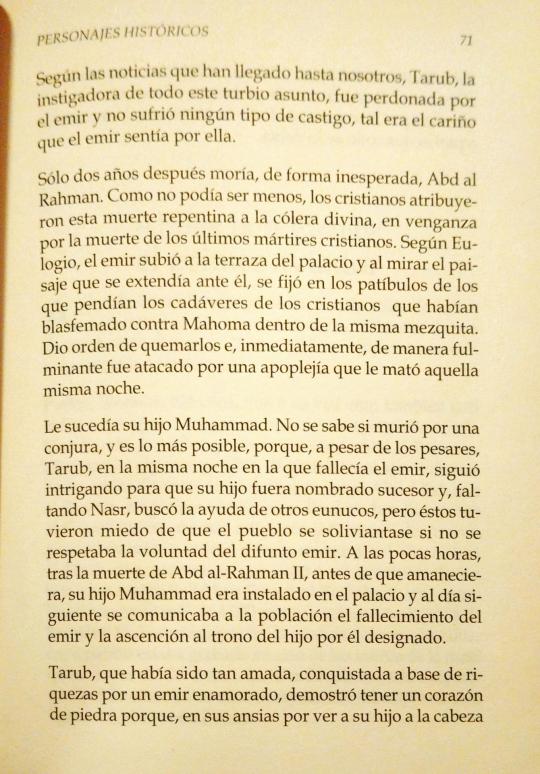
According to the news that has reached us, Tarub, the instigator of all this murky affair, was forgiven by the emir and did not suffer any type of punishment, such was the affection that the emir felt for her.
Only two years later, Abd al Rahman died, unexpectedly. The Christians attributed this sudden death to divine anger, in revenge for the death of the last Christian martyrs. According to Eulogio, the emir went up to the terrace of the palace and, looking at the landscape that stretched before him, noticed the scaffolds from which hung the corpses of the Christians who had blasphemed against Muhammad within the same mosque. He gave the order to burn them and, immediately, in a sudden manner, he was attacked by an apoplexy that killed that same night.
He was succeeded by his son Muhammad. It is not known if he died as a result of a conspiracy, and it is the most possible, because, despite the regrets, Tarub, on the same night in which the emir, continued to intrigue so that his son would be named successor and, with Nasr missing, she sought the help of other eunuchs, but they were afraid that the people would became angry if the will of the late emir was not respected. A few hours after the death of Abd al-Rahman II, before dawn, his son Muhammad wasinstalled in the palace and the next day the population was informed of the death of the emir and the ascension to the throne of the son designated by him.
Tarub, who had been so loved, conquered with wealth by an emir in love, proved to have a heart of stone because, in her eagerness to see his son in the lead

of the emirate of Cordoba, we do not know if due to an understandable love as a mother, or simply, to the ambition that she always displayed, she did not hesitate to consider the death of the one to whom she owed everything.

Abbas ben Firnas: the first aviator
Abd al-Rahman II was, without a doubt, the most cultured of all the emirs and Hispano-Umayyad caliphs. Only one of his descendants, al-Hakam II, could compare him in terms of intellectual curiosity.
Poets, writers, philosophers, who in turn were also almost all astrologers, to whom which the Muslims attached so much importance, were part of the court by Abd al-Rahman. We will mention some of them, of great talent, who excelled in different areas of knowledge, such as Abd Allah ben al-Shamir, magnificent versifier; Ibrahim ben Sulayman al-Shamí, whose religious and mystical poems achieved great relevance throughout the Muslim world; Uthman ben al-Muthanna, grammarian, who became a preceptor to the royal princes; Said ben Farach al-Rashshash, who knew more than 4,000 mnemonics poems by heart and his brother Muhammad, who established the measurement of the Andalusian cubit, whose pattern was engraved on one of the walls of the main mosque from Córdoba... The list of wise men would be very long. But among all of them the figure of Abbas ben Firnas is especially important.

If we had to describe the personality of Abbas ben Firnas we could say that it was a being in every way singular. He was of Berber origin and belonged to a family that lived in the district of what is now Ronda. His creative ability and his inventiveness had no limits, and in addition, he was endowed with physical dexterity out of the ordinary. Skilled conjurer, he amazed anyone with his ingenious sleight of hand and occult sciences were his specialty. Was as admired as envied by other wise men like him. The strangest and most difficult enigmas seemed to show themselves, with complete clarity, before their understanding, as could be verified with the treatise on Arabic metrics of Jalil. This book arrived in Spain, like so many others that Abd al-Rahman II had brought from Persia and Baghdad, through a merchant, and no one was able to decipher his content. The book was abandoned, as useless, in one of the libraries of palace, until our man came across it, read it carefully, and instantly understood what its pages said, deciphering it before a audience that was left with their mouths open.
With a series of devices of his invention, he discovered the formula for the manufacturing glass and built, in a vaulted room in his house, a dome that imitated the sky, which at will made it clear or cloudy, adding lightning and thunder. But this invention that left everyone stunned, aroused the envy of another competitor, because then just as that now, there is no creation or discovery that does not have its detractors, motivated more by spite than by a healthy desire to improve what was
#al andalus historical figures#al andalus personajes históricos#book scans#bookblr#historyblr#al andalus#al andalus history#ziryab#zyriab the singer of baghdad#abu l-hasan ali ibn nafi`#abd al rahman ii#abd al rahman ii of córdoba#tarub#abbás ibn firnás#emirate of cordoba#spanish history#tw death#tw mysoginy#(for tarub's chapter)
14 notes
·
View notes
Text
La Bola is a classic Madrid tavern. Located on a quiet backstreet, it is painted lacquer red on the outside, with a dark wood and colored tile interior. We arrived during a busy Sunday lunch service. The place was filled with multigenerational families and loud groups of friends who, like us, were there for the jewel of the crown, the most Madridian dish of all: Cocido madrileño, a stew that La Bola has perfected in its 150 years of operation.
Cocido madrileño (“the stew of Madrid” in Spanish) is a rustic dish of chickpeas, vegetables such as potatoes and cabbage, and a variety of pork cuts, sausages and marrow bones. At La Bola it is still cooked the traditional way, layered in individual clay pots over coal. The stew is served over two courses, making for a full meal. First, the busy waiter poured the cooking liquid out of the cocido pot into a soup bowl filled with vermicelli noodles, to be eaten like a soup. The chickpeas, vegetables and meats were placed on a platter for the main course (some serve the chickpeas for a second course and the meat with veggies for third). The scene repeated itself at almost every table in the packed restaurant, with guests watching in anticipation as the waiters laid out the cocido spread.
But as it turns out, the roots of this Madrid staple, this pork-laden stew, are deep in the medieval Sephardi community of Spain. Specifically, in a Shabbat overnight stew called adafina (AKA dafina, tfina and s’khina).
To understand the dish’s amazing evolution, we need to look way back.
Muslims conquered the Iberian Peninsula in the early eighth century. They brought religious moderation to Al Andalus, in addition to new dishes, spices, fruits and cooking techniques. Since Jews and Muslims both avoid pork, their cuisines at the time were very similar.
Cooking stews overnight, over or under coal, was a technique used by Muslims while still in the Levant. But in Al Andalus, it was the Jews who were most identified with this cooking method, mainly because it was a good practice for Shabbat, when lighting fire is not allowed. The word adafina comes from the Arabic word for “hidden” or “buried,” since the dish was cooked while buried under coal, though the dish is also known as ani or calinete (“hot” in Spanish) or hamin (“a warm dish” in Hebrew, a name that was used for Shabbat dishes in the Talmud).
Adafina, just like cocido madrileño, consists of chickpeas, vegetables, meat (lamb) with the occasional addition of hard-boiled eggs (huevos haminados) cooked together at a low temperature overnight. Adafina is still prepared by Tunisian and Moroccan Jews of Sephardi descent around the world. Through the years, more ingredients were added to the pot, most notably potatoes from the new world, as well as wheat berries, sometimes tied in a cloth, and a sweet loaf of ground beef.
According to author and food historian Claudia Roden, Moroccan adafina was served in several courses, first potatoes and eggs with plenty of the soup, then the wheat and/or rice and lastly the meat with chickpeas. Just like the cocido is served in Madrid today.
The first cookbook available to us from the Iberian Peninsula is the 13th century Andalusian “Kitab Al Tabikh.” It includes six Jewish recipes, and two of them use the technique of covering the pot with another pot of coal to keep it warm. A third recipe, described as “Stuffed, Buried Jewish Dish,” is called Madfūn, an Arabic word that comes from the same root as adafina, to bury. Although the recipe is different to what we know as adafina today, the method of cooking it for a long time under coal is the same.
With the expulsion of the Jews from Spain in 1492, many left to Portugal, North Africa and the Ottoman Empire, where for 500 years they kept their prayers, language (Judeo-Spanish or Ladino) and their unique cuisine, which is why adafina is present in Moroccan homes today.
Those who stayed in Spain were forced to convert to Catholicism. To enforce the sincere conversion and prevent the conversos (converts) from practicing their Judaism in secret, the monarchy used the Inquisition, an institution that kept its devastating work well into the 19th century.
One of the ways the Inquisition spied on and convicted heretic conversos was by observing their food. They published guides with detailed descriptions of Shabbat dishes, matzah on Passover, eggplant dishes and the avoidance of pork. Interestingly, the conversos themselves, having no other resource available, used those same lists in order to learn how to keep their Jewish customs alive. Neighbors and servants reported their suspicions to the Inquisition authorities. And so adafina became one of the most incriminating dishes, punishable by cruel execution.
A letter written by an eager informer to King Ferdinand in 1516 says that “nearly all the residents of this city [Seville] smell Jews, them, their houses and the doors of their houses, because they are gluttons and pigs, and they nourish themselves with casseroles, garlic and adafinas,” as documented in Hélène Jawhara Piñer’s book “Jews, Food, and Spain.”
But if the roots of cocido madrileño are, in fact, in the Jewish Sephardi adafina, why is it full of pork?
While many conversos saw avoiding pork as the most important Jewish law to keep, others deliberately consumed pork in public in order to avoid any suspicion. “The conversos of Majorca were known as Xuetes (“xua” meaning “bacon” in Majorcan Catalan), explains Paul Freedman in his book “Why Food Matters.”
“Because their ancestors cooked and ate bacon in public to show their sincerity, but they only did this once or twice a year.”
“The one way to demonstrate that they [the conversos] now are Christian was to eat pork, so they introduced pork into the most famous dish they ate, adafina,” Mara Verdasco Arevalo, La Bola Tavern’s manager and owner, told me in an email.
For hundreds of years after the expulsion, Spain had no Jewish community and the Jewish roots of many staples of Spanish cuisine were all but forgotten. In recent years, Spain has been making an effort to revive its elaborate Jewish history. Spanish governments have worked to renew Jewish quarters around the country, began issuing Spanish passports to Sephardim and opened new Jewish museums. Hopefully a thorough research of Spain’s culinary heritage, acknowledging the Muslim and Jewish roots, will be part of it.
12 notes
·
View notes
Text
Historic Centre of Cordoba
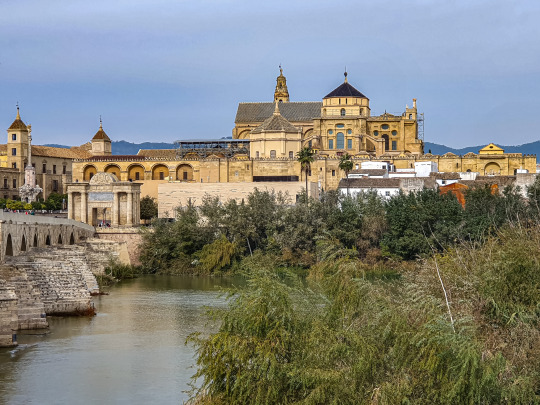
Join me on a virtual exploration of the Historic Center of Cordoba in Spain, a UNESCO World Heritage Site that weaves together centuries of history, architectural brilliance, and a harmonious blend of cultures. Let's wander through the narrow streets and discover the enchanting beauty that defines this Andalusian gem.
Cordoba's Historic Center earned UNESCO World Heritage status in 1984, recognizing its outstanding universal value and the preservation of its architectural and cultural legacy. The inscription celebrates the city's role as a meeting point for different cultures over the centuries.
Behold the Mezquita-Cathedral, an architectural marvel that encapsulates the city's history. Originally a mosque during the Islamic period, the structure later transformed into a cathedral, embodying the coexistence of Islamic and Christian influences in Cordoba.
Explore the Alcázar, a fortress that witnessed the fusion of Moorish and Christian cultures. With its beautiful gardens, reflecting pools, and historic significance, the Alcázar narrates tales of medieval power struggles and cultural exchange.
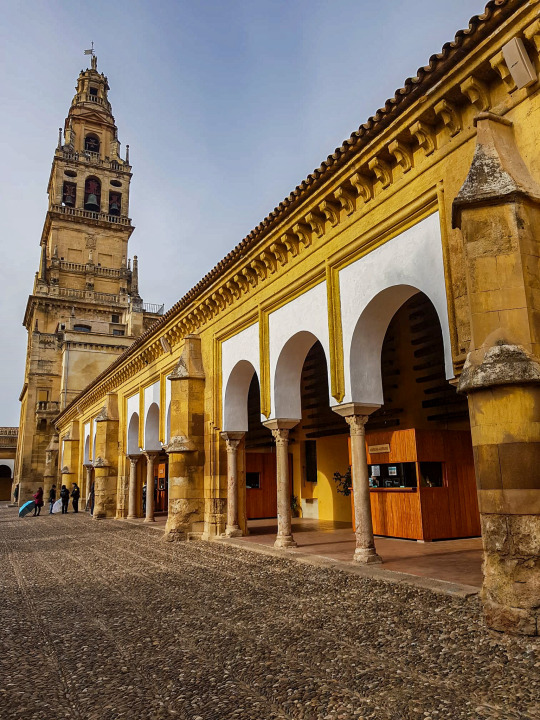
Navigate the labyrinthine streets of the Jewish Quarter, or Judería, where whitewashed houses, cobblestone streets, and charming squares create an enchanting atmosphere. The Synagogue of Cordoba, a hidden gem, stands as a testament to the city's Jewish heritage.
Stroll down the iconic Calleja de las Flores, a picturesque alley adorned with vibrant flowers that frame the view of the Mezquita-Cathedral. This charming lane captures the essence of Cordoba's Andalusian charm.
Participate in the annual Patio Festival, where residents open their homes to showcase the beauty of their traditional Andalusian patios. Bursting with flowers and adorned with intricate tilework, these patios offer a glimpse into Cordoba's private architectural treasures.
Indulge in the culinary delights of Cordoba, where traditional Andalusian cuisine takes center stage. From savory tapas to the refreshing flavors of salmorejo, the city's gastronomy is a delightful journey through the region's rich culinary heritage.
In conclusion, Cordoba's Historic Center beckons us to unravel the layers of its history, where diverse cultures have left an indelible mark on its streets and monuments. When you're ready for a virtual stroll through the ages, Cordoba promises to captivate and inspire. 🏰🌺🇪🇸
#cordoba#spain#europe#unesco#world heritage#historic#center#city#town#andalusia#charm#travel#architecture#culture
5 notes
·
View notes
Text
Best Food, Wine & Private Tours in Seville and Andalusia
🍷 Food & Wine Experiences in Andalusia
Andalusia is a haven for food and wine enthusiasts. Embark on a journey through the region's diverse flavors with Flavors of Andalucía. From tasting world-renowned olive oils to sampling exquisite local wines, these experiences are designed to immerse you in the authentic tastes of the region.
For a more in-depth exploration, consider the Private Food Tour Penedès. This four-day adventure takes you through Catalonia's prestigious wine country, offering visits to renowned bodegas, hands-on cooking lessons, and luxurious accommodations.
🎶 Tapas and Flamenco Show in Seville
Immerse yourself in Seville's vibrant culture with a combined tapas and flamenco experience. Enjoy a guided tour through the city's historic neighborhoods, sampling traditional tapas dishes, followed by an authentic flamenco performance that captures the soul of Andalusia.
🍽️ Best Tapas Tour in Seville
Discover the heart of Seville's culinary scene with the Best Tapas Tour Seville. This three-hour private tour takes you to family-run tapas bars, offering a taste of traditional dishes paired with local wines. Explore the Santa Cruz, Alfalfa, and Plaza de Encarnación neighborhoods, and conclude your journey with a rooftop drink overlooking the city's iconic landmarks.
🏛️ First Day Sightseeing in Seville
Begin your Seville adventure by exploring its most iconic sites. Visit the majestic Seville Cathedral, the largest Gothic cathedral in the world, and the historic Alcázar, a royal palace renowned for its stunning architecture and lush gardens. Stroll through the charming Santa Cruz district, once the Jewish quarter, and soak in the city's rich history and vibrant atmosphere.
🚗 Private Visit from Seville to Córdoba
Enhance your Andalusian journey with a private day trip from Seville to Córdoba. Explore the city's rich Moorish heritage, highlighted by the breathtaking Mezquita, a mosque-cathedral that stands as a testament to Córdoba's diverse history. Wander through the picturesque Jewish quarter, and experience the city's unique blend of cultures.
🗺️ Private Day Tours and Sightseeing in Seville
For a personalized exploration of Seville, consider private day tours that cater to your interests. Whether you're passionate about history, architecture, or cuisine, Flavors of Andalucía offers tailored experiences that provide deeper insights into the city's treasures. From guided walks through historic districts to exclusive culinary adventures, these tours ensure a memorable Seville experience.
Embark on a journey through Andalusia's rich cultural and culinary landscapes. With expert guides and personalized itineraries, your Andalusian adventure promises to be as unique as it is unforgettable.
#Food wine experiences in Andalucia#Tapas and flamenco show seville#Tapas Tour Seville#Seville First day Sightseeing#Private visit from Seville to Cordoba#Private day tours Seville#Private sightseeing Seville
0 notes
Link
Bab Al Fahs | Tanger Have you ever yearned to step into a realm where history whispers through ancient walls and cultural riches infuse the air you breathe? Imagine a place where every alleyway tells a story, every door hides a secret, and every step you take creates a melody of the past. Let me introduce you to Bab Al Fahs in the majestic city of Tangier - a true gem awaiting your discovery. **Immerse Yourself in History** As you cross the threshold of Bab Al Fahs, you are transported back centuries to a time when merchants bartered at bustling markets and caravans embarked on daring journeys across the vast desert. This historic gateway, dating back to the 15th century, stands as a testament to Tangier's strategic importance and its vibrant past as a melting pot of cultures. **Architectural Splendor Unveiled** Marvel at the intricate details of the ancient arches and imposing walls that have withstood the test of time. The blending of Moorish and Andalusian architectural styles creates a visual masterpiece that will leave you in awe. As sunlight filters through the ornate carvings and patterns, a sense of wonder and reverence fills your heart. **A Cultural Tapestry** Step into the heart of Bab Al Fahs, where the echoes of historical events resound, and the spirit of Tangier's diverse heritage shines brightly. From the vibrant colors of local artisans' crafts to the tantalizing aromas of traditional cuisine wafting through the streets, every sense is awakened, inviting you to explore and indulge in a cultural feast like no other. **Let Your Curiosity Lead the Way** So, dear traveler, are you ready to embark on a journey of a lifetime? Allow Bab Al Fahs in Tangier to be your guide through a tapestry of tales, a symphony of sights, and a treasure trove of experiences waiting to be uncovered. Come, wander through the gates of Bab Al Fahs and let the essence of Tangier seep into your soul, leaving an indelible mark on your travel memories. Are you ready to be enchanted? #BabAlFahs #TangierMagic #HistoricGateway #MoroccanDreamscape #CulturalWhispers
0 notes
Note
Here goes... :->
Black pudding is the Irish / UK name for a sausage made with blood - pig, cow or sheep - rather than chopped or minced meat as the main ingredient, forms of which are found in cuisines all over the world.
Black pudding can be long or short, straight or curved ("stick" or "ring"), and sometimes even a cake or terrine.




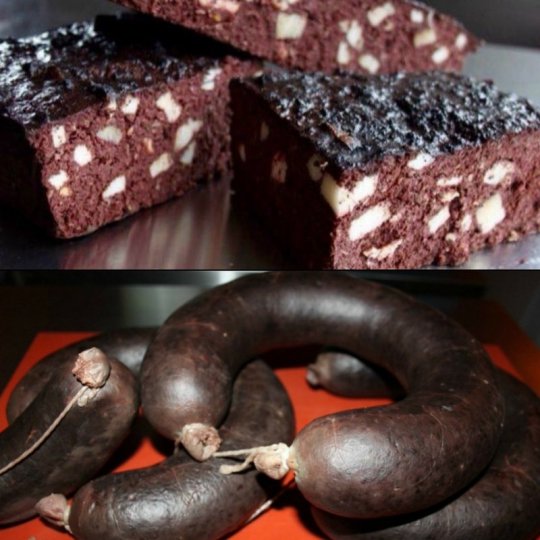
The "pudding" part, which USAians associate with a sweet dessert, comes from the French word "boudin" (boudin noir is French blood sausage) and seems to have something to do with "edible material inside a wrapper" - the wrapper may also be edible, like the skin on a sausage or black pudding...

...and the suet crust of a steak-and-kidney pudding...

...or inedible like the cloth or bag used for a boiled pudding. This is how Christmas puddings used to be made, hence Dickens writing that the Cratchit house smelled like a laundry, and why traditional images show them as spherical with a sprig of holly on top.

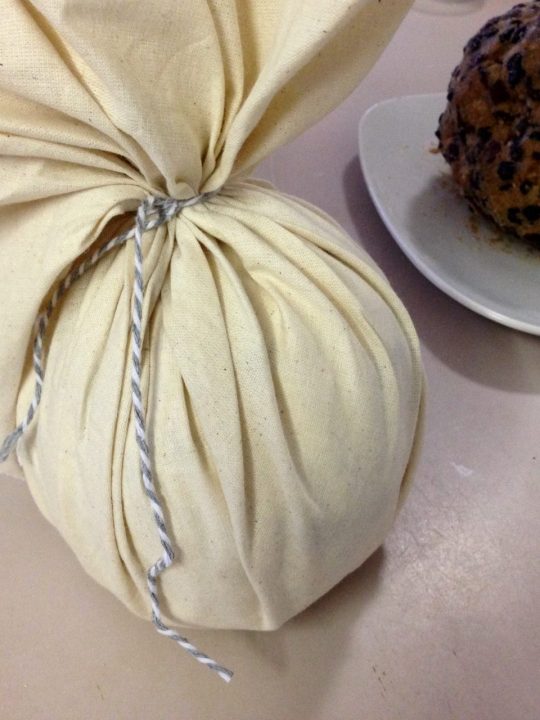
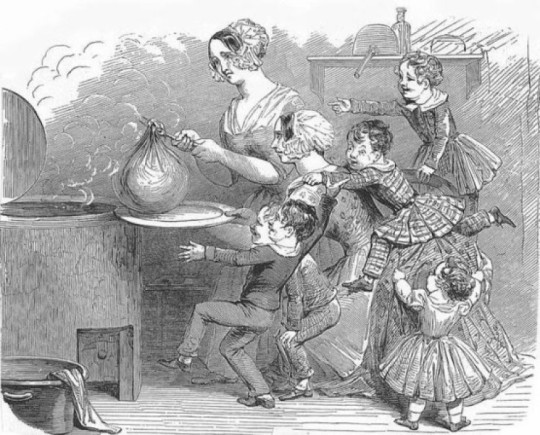

Black puddings are also boiled before going on sale, so they're actually cooked and ready-to-eat, though I've never heard of anyone hereabouts doing so.
Usually they become an ingredient in a recipe such as this salad (one of DD's Middle Kingdoms dishes)...
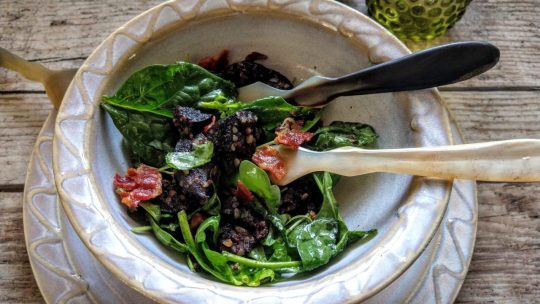
... or appear sliced as part of a fry-up.
The black puddings I'm most familiar with (Irish / UK) mostly use pig-blood, oats or barley and various herbs and spices. They're a standard part of a Full Irish Breakfast / Ulster Fry - just the sort of thing to start a day that involves ploughing a 40-acre field behind two Shire horses, though perhaps best eaten infrequently if just sitting at a desk.
This is pretty close to the sort of Ulster Fry I grew up with, including the black pudding...

...though there should also be a slice of white pudding (minced pork, oats or barley, spices) and that ordinary fried bread, nice though it looks, would be a half farl of soda and a couple of farls of potato bread instead.
(For those familiar with a Full English Breakfast and wondering "Why no baked beans?", AFAIK there should never be baked beans with an Ulster Fry since, unlike everything else, they can't be fried - which, as the name suggests, is the whole point...)
Black puddings were used as weapons (!) for "the Yorkshire martial art of Ecky Thump" (!!) in an episode of 1970s comedy show "The Goodies"; this is the notorious episode where a TV viewer died of laughter...
There are regional variants of black and white pudding all over these islands: Stornoway black pudding from Scotland, Pwdin Du from Wales, Bury black pudding in the Midlands (oops!) North-West *, Hog's Pudding in the West Country and so on.
( * Lancashire, where the martial art is By 'Eck. Possibly.)
Perhaps the best known Irish black pudding variant is "drisheen" from Cork and Limerick; its signature herb is tansy, and oatmeal rather than barley gives a softer texture than regular pudding.

Cork and Limerick were major Viking settlements, so I wonder if there's some association between drisheen with tansy and Scandinavian blood sausages with marjoram and other herbs.
That notion was first prompted by Frans Bengtsson's well-researched novel "The Long Ships"; Michael Meyer's excellent translation is the usual English version.
There, black pudding - or at least blood sausage "with thyme in it" - provokes a tearful emotional response from two hard-bitten Vikings who, after several years as slaves then mercenaries in Andalusian (Muslim) Spain, get their first taste of Real Grub at King Harald Bluetooth's Yule feast.
The book version's a bit long, but you can get the picture (hah!) from a couple of frames of the graphic novel.

Wild boar, bread cakes and fried turnips were carried in, but when the blood-sausage came, Orm and Toke got tears in their eyes. "That scent is best of all!" "There's thyme in it..."

"Please, if it's not against Harald's orders, could we have some more? For seven years we've been eating vegetables in the land of the Andalusians. We've missed seven Yules-worth of blood-sausage!"
Back in 1987, I felt the same way about foods from home after only 6 months in Los Angeles - and yes, one of those foods was black pudding...
So I'm the one who asked about the beans in the English breakfast a day ago and I was reading the notes and-- what the actual fuck is black pudding? Never heard of it, not sure I even want to know, but now I feel bad for missing ANOTHER thing in the English breakfast.. also my dad devoured the food before my mom could say "beans are off, love" but we will remember it for next time!
I will let someone in the notes describe and explain Black Pudding. Someone will take joy in it.
#food and drink#black pudding#blood sausage#irish cuisine#uk cuisine#the long ships#book recommendations
3K notes
·
View notes
Text
Cobalto Restaurant: A Celebration of Authentic Italian Cuisine in the Heart of Málaga
Introduction
Located in the sun-drenched city of Málaga, Cobalto Restaurant is more than just a dining spot—it's a destination for lovers of genuine Italian flavors. Whether you're searching for a cozy restaurant italiano, the best pasta near me, or an elegant dinner experience with a view, Cobalto is the perfect match. Emphasizing freshness, regional Italian ingredients, and culinary tradition, Cobalto Restaurant has become a favorite for both locals and tourists alike. From handcrafted pasta to beautifully presented vegetarian dishes, the restaurant redefines what it means to enjoy Italian cuisine in southern Spain.
Discovering a True Restaurant Italiano in Málaga
Cobalto Restaurant brings the romance and authenticity of Italy to the Andalusian coast. From the moment you walk in, you are greeted by the warm tones of Mediterranean décor, the aroma of fresh herbs, and the subtle sounds of Italian jazz in the background. The ambiance sets the stage for a culinary journey through Italy, where each dish tells a story of regional heritage and artisanal care.
At Cobalto, the menu is designed to reflect the diversity and richness of Italian gastronomy. Whether you're a fan of Northern Italy's creamy risottos or the bold tomato-based dishes of the South, there is something to satisfy every palate. The restaurant prides itself on being one of the few places where the essence of a restaurant italiano is captured so elegantly outside of Italy.
Pasta Málaga Will Remember
If you’ve been hunting for standout pasta Malaga options, Cobalto is the answer to your cravings. The restaurant’s pasta selection is extensive and constantly evolving. Signature dishes like Tagliatelle al Tartufo (truffle tagliatelle), Pappardelle alla Bolognese, and Spaghetti al Limone con Gamberi (lemon spaghetti with shrimp) are not only visually stunning but also packed with depth of flavor.
Each pasta is handmade daily in-house using traditional Italian techniques. This ensures perfect texture, flavor retention, and the kind of freshness that industrial pasta simply cannot deliver. The sauces are slow-cooked, made from scratch with premium olive oil, San Marzano tomatoes, fresh garlic, and herbs harvested from local and Italian farms.
Cobalto is not just a place to eat pasta—it’s where you discover what real pasta should taste like. It’s no wonder it frequently tops the list when people search for the best pasta near me in Málaga.
An Italian Gem Near Me for All Occasions
For those looking up a restaurant near me while exploring Málaga, Cobalto is a standout destination conveniently located in a bustling yet charming part of the city. Whether you’re celebrating a special occasion, planning a romantic date, or just indulging in a quiet dinner for one, the welcoming atmosphere and attentive staff make every meal a memorable one.
What distinguishes Cobalto is its flexibility. It caters to families, solo diners, couples, and groups, all while maintaining the intimacy and elegance of a fine Italian restaurant. The wine list is curated with passion, showcasing Italian favorites from Tuscany, Veneto, and Sicily, along with select Spanish bottles to harmonize local flavors with traditional Italian dishes.
Embracing Vegetarian Delights with Italian Flair
Cobalto understands the importance of variety and inclusivity, which is why the menu features a beautiful selection of vegetarian dishes. In true Italian fashion, vegetables are not an afterthought—they’re the stars of many plates. Dishes like Melanzane alla Parmigiana (eggplant Parmesan), Risotto ai Funghi Porcini, and Gnocchi with Sage Butter are expertly crafted to satisfy both vegetarians and meat-eaters alike.
Even better, the restaurant collaborates with local farms to source seasonal produce, ensuring vibrant flavors and sustainable practices. Cobalto’s chefs believe that vegetarian Italian food doesn’t need to compromise—it should shine with the same richness, texture, and complexity as any other dish.
The Experience of Italian Near Me: Beyond Food
When guests type “Italian near me” into their search bar, they often seek more than just a plate of pasta. They’re looking for atmosphere, warmth, and that sense of being transported to another country. Cobalto excels in this regard by creating a complete Italian experience. From imported tableware to the carefully chosen music playlist and the warm hospitality of the staff, every detail reflects the spirit of Italy.
The interior design, combining rustic wooden elements with modern elegance, evokes a timeless Italian aesthetic. Whether you're seated indoors or enjoying the fresh air on the terrace, you’ll feel a perfect blend of comfort and sophistication. It’s the kind of place that invites you to slow down, savor your wine, and enjoy every course without rushing.
Seasonal Specials and Chef’s Creations
A standout feature of Cobalto Restaurant is its commitment to innovation. In addition to its staple menu, the restaurant offers seasonal specials that spotlight lesser-known Italian recipes and ingredients. These dishes are often inspired by the chef’s personal travels through Italy or family recipes handed down through generations.
Seasonal highlights have included Pumpkin Ravioli with Amaretti Crumble, Octopus Carpaccio with Lemon Zest and Olive Oil, and Black Ink Tagliolini with Clams and Parsley. Each creation is presented with artistic flair, making dining at Cobalto a feast for the eyes as well as the palate.
Handmade Desserts and Italian Coffee Culture
No Italian meal is complete without a sweet ending, and Cobalto’s dessert menu is a triumph of Italian pastry and gelato traditions. Favorites include Tiramisu, Panna Cotta with Berries, and Cannoli Siciliani filled with ricotta and orange zest. Each dessert is made in-house with the same level of attention as the main courses.
To round off your meal, you can indulge in a genuine Italian espresso or cappuccino, prepared using beans sourced from premium Italian roasters. Cobalto celebrates Italian coffee culture, where sipping a well-made espresso is not just a caffeine fix—it’s a cherished ritual.
Events, Wine Tastings, and Private Dining
Cobalto goes beyond everyday dining by hosting regular events like Italian wine tastings, cooking classes, and private chef nights. These events are perfect for anyone wanting to deepen their appreciation of Italian cuisine and wine culture.
For more intimate gatherings, the restaurant offers a private dining room that can be customized for birthdays, anniversaries, business dinners, or romantic proposals. These exclusive experiences bring a personal touch that elevates any special moment.
A Commitment to Excellence and Authenticity
What makes Cobalto Restaurant a favorite for those searching for a restaurant italiano in Málaga is not just its menu, but its unwavering dedication to authenticity and excellence. The team behind Cobalto includes experienced chefs, Italian-born restaurateurs, and passionate food lovers who believe that dining should be an immersive, joyful experience.
By focusing on quality ingredients, traditional techniques, and heartfelt hospitality, Cobalto has carved out its place as one of the most beloved Italian dining spots in the region.
0 notes
Text
Planning the Perfect 1-Week Trip to Spain

Spain, with its vibrant cities, breathtaking landscapes, and rich cultural heritage, is an ideal destination for a week-long adventure that combines history, cuisine, and scenic beauty. Whether you’re a solo traveler craving the freedom of the open road or someone eager to immerse yourself in Spain’s charm, careful planning ensures an unforgettable trip. Here’s a detailed guide to crafting the perfect 7-day itinerary, covering ideal destinations, scenic motorways and mountain routes for solo drives, vehicle rental options, how to apply for an International Driving License online, top restaurants for traditional cuisine, the best visiting month, and a must-attend festival.
Perfect Destinations to Cover in One Week
To experience Spain’s diverse offerings in just one week, focus on a mix of iconic cities and natural wonders. Start in Madrid, spending two days exploring the capital’s cultural treasures. Visit the Royal Palace, stroll along Gran Vía, and dive into the art at the Prado Museum. On day three, take a short trip to Toledo, a medieval city just an hour’s drive or train ride away, known for its narrow streets and stunning Alcázar. Next, head south to Seville for two days, where you can marvel at the Giralda Tower, wander through the Alcázar of Seville, and soak in the Andalusian atmosphere. On day six, drive to Granada to see the breathtaking Alhambra, a masterpiece of Moorish architecture. Conclude your trip on day seven in Barcelona, a two-and-a-half-hour train or drive from Granada, where you can explore Sagrada Família, Park Güell, and the lively La Rambla. This itinerary balances urban excitement with historical depth, making it perfect for first-timers.
Motorways and Mountain Routes for Solo Drives
Spain’s road network is excellent for solo drivers, offering both efficient motorways and scenic mountain routes. For quick travel between cities, use major motorways like the AP-7 (Mediterranean Highway), connecting Barcelona to the south, or the AP-6 and AP-2, linking Madrid to northern regions. These toll roads are well-maintained and safe, with speed limits typically at 120 km/h, but ensure you have cash or a credit card for tolls, as some require payment. For stunning scenery, the Sierra Nevada route near Granada offers breathtaking mountain drives, with winding roads showcasing snow-capped peaks and lush valleys—ideal for a solo adventure. Another gem is the Pyrenees Mountain roads in northern Spain, particularly around Zaragoza, where routes like the N-260 provide dramatic vistas of jagged peaks and serene lakes. These routes, while narrower, are perfect for experiencing Spain’s natural beauty at a leisurely pace, though caution is advised due to potential wildlife or rock slides.
Ways to Rent a Car or Bike
Renting a vehicle in Spain is straightforward and enhances your flexibility. Major international companies like Hertz, Avis, and Sixt operate at airports and cities, offering cars for as little as €30 per day for a small manual vehicle, though automatic options cost more. Ensure you’re at least 21 (some require 23) and have held your license for over a year. For solo travelers, a compact car is ideal for navigating city streets and rural roads. Motorbikes are also available, especially in tourist hubs like Barcelona and Madrid, through local providers or apps like DiscoverCars.com or RentalCars.com, which aggregate deals and reviews. You’ll need a valid driver’s license and, for non-EU citizens, an International Driving Permit Spain (IDP). Check rental terms for insurance, as comprehensive coverage (including zero excess) is recommended, and always inspect the vehicle for damage before driving off.
How to Apply for an International Driving License for Spain Online
For non-EU drivers, an International Driving Permit (IDP) is strongly recommended to supplement your national license when driving in Spain. You can apply online through trusted providers like e-ITCA (e-itca.org), which offers a fast and secure process. Here’s how: Visit the e-ITCA website, where you’ll need to upload a valid driver’s license, provide two passport-sized photos, and pay a fee (typically around $20-$30, depending on your location). No driving test is required; the IDP serves as a translation of your license and is issued within 15 minutes. Ensure your national license is current, as it must accompany the IDP. For U.S. citizens, the American Automobile Association (AAA) also offers online applications, but e-ITCA is a convenient option for quick processing. Apply at least a few weeks before your trip to ensure delivery, and check Spain’s requirements, as EU licenses are valid without an IDP but non-EU licenses benefit from this additional documentation.
Best Restaurants for Traditional Cuisine and Must-Try Foods
Spain’s culinary scene is a delight, blending regional flavors with global influences. In Madrid, dine at Botín, the world’s oldest restaurant (est. 1725), famous for its roast suckling pig and traditional Spanish omelette (tortilla española). In Seville, visit El Rinconcillo, another historic spot, for authentic Andalusian tapas like gazpacho (cold tomato soup) and jamón ibérico (cured ham). In Barcelona, Can Culleretes, established in 1786, serves classic Catalan dishes such as pa amb tomaquet (bread with tomato) and fideuà (a seafood noodle dish). Don’t miss paella in Valencia (if you extend your trip) or churros con chocolate for a sweet treat anywhere in Spain. These restaurants offer a taste of Spain’s heritage, with warm ambiance and dishes that highlight local ingredients like olive oil, saffron, and seafood.
Best Visiting Month and Festival to Attend
The ideal time to visit Spain is during the shoulder seasons of April to May or September to October, when temperatures are mild (15-25°C), crowds are thinner, and prices are lower than peak summer. Spring brings blooming landscapes, while autumn offers harvest festivals and cooler weather, perfect for driving and sightseeing. Avoid July and August, as they can be excessively hot (up to 35°C) and crowded, especially in southern regions. For a cultural highlight, plan your trip around La Tomatina in Buñol (late August, usually the last Wednesday), a world-famous tomato-throwing festival that’s both chaotic and unforgettable. If your dates don’t align, consider Feria de Abril in Seville (April), a week-long celebration of Andalusian culture with flamenco, parades, and traditional food, offering a deep dive into Spanish festivities.
Final Thoughts
With this 1-week itinerary, you’ll experience Spain’s essence—from Madrid’s grandeur to Seville’s charm, Granada’s history, and Barcelona’s vibrancy—while enjoying scenic drives and savoring its cuisine. Renting a car or bike, securing an IDP via e-ITCA, and timing your visit for spring or autumn ensure a smooth and enriching trip. Whether you’re cruising the AP-7 or navigating the Pyrenees, Spain’s roads and culture promise adventure and beauty at every turn. Safe travels!
0 notes
Text
Tunisian Sweets: A Journey Through Tradition and Taste
Tunisian cuisine is a vibrant tapestry woven from centuries of cultural exchange, blending Berber, Arab, Andalusian, and Mediterranean influences. Among its most delightful threads are the sweets—delicacies that have long been cherished for their intricate preparation and rich flavors. During the French colonial period in the early 20th century, French scholars and scientists, including doctors,…
0 notes
Text
Discover Luxury Living: Penthouse for Sale in Costa del Sol Spain
The Allure of Costa del Sol: A Mediterranean Paradise
Costa del Sol, Spain, is a dream destination that perfectly blends luxurious living with breathtaking natural beauty. With its golden sandy beaches, stunning coastline, and warm Mediterranean climate, it has become a sought-after haven for property buyers worldwide. From the vibrant nightlife of Marbella to the tranquil seaside charm of Estepona, this region offers something for everyone. Whether you seek a holiday retreat, an investment opportunity, or a permanent residence, buy property in Costa del Sol Spain to experience the ultimate in refined living.
Why Choose a Penthouse in Costa del Sol?
Owning a penthouse in Costa del Sol is more than just a property investment—it’s a lifestyle upgrade. Penthouses provide exclusivity, breathtaking panoramic views, and unparalleled privacy. With spacious terraces, modern designs, and state-of-the-art amenities, these properties redefine luxury. Imagine waking up to the serene sounds of the Mediterranean, sipping coffee on a sun-drenched terrace, and enjoying sunsets that paint the sky in hues of gold and crimson. A penthouse for sale in Costa del Sol Spain offers all this and more, making it the ultimate choice for discerning buyers.
Investment Potential: A Smart Move for Property Buyers
Costa del Sol’s real estate market continues to thrive, attracting investors from all over the world. The high demand for luxury properties, coupled with the region’s flourishing tourism industry, makes purchasing a penthouse a smart financial move. Rental yields are impressive, with many investors securing lucrative returns by leasing their properties to holidaymakers and expatriates. With a steady increase in property values, now is the perfect time to buy property in Costa del Sol Spain and secure a valuable asset for the future.
Prime Locations for Penthouse Living
From Marbella’s prestigious Golden Mile to the charming town of Benalmádena, Costa del Sol offers numerous prime locations for penthouse living. Marbella remains the epitome of luxury, boasting exclusive beachfront
properties, world-class golf courses, and designer boutiques. For those seeking a quieter ambiance, Estepona presents a perfect blend of traditional Andalusian charm and modern luxury. Puerto Banús, famed for its glamorous marina and upscale lifestyle, is another hotspot for high-end penthouses. No matter your preference, there is a penthouse for sale in Costa del Sol Spain that matches your vision of opulence.
The Unmatched Lifestyle of Costa del Sol
Beyond its real estate appeal, Costa del Sol offers a lifestyle that is second to none. The region boasts over 300 days of sunshine a year, making it an ideal location for outdoor enthusiasts. Golfers can indulge in some of Europe’s finest courses, while food lovers can savor exquisite Mediterranean cuisine at Michelin-starred restaurants. The vibrant nightlife, high-end shopping districts, and cultural attractions add to the area’s charm. By choosing to buy property in Costa del Sol Spain, you gain access to an unparalleled lifestyle filled with luxury, leisure, and endless opportunities for adventure.
Navigating the Buying Process with Ease
Purchasing a penthouse in Spain requires careful planning and expert guidance. Working with experienced real estate professionals can simplify the process, ensuring a smooth transaction from start to finish. Legalities such as obtaining an NIE (Número de Identificación de Extranjero), understanding taxes, and securing financing should be meticulously handled to avoid complications. Many real estate agencies offer tailored services, assisting buyers every step of the way to make their dream of owning a penthouse for sale in Costa del Sol Spain a reality.
A Lifetime of Luxury Awaits
Costa del Sol is more than just a location; it’s a way of life that embodies elegance, comfort, and exclusivity. Whether you are looking for a permanent residence, a vacation retreat, or a profitable investment, this region has something to offer. The perfect penthouse is waiting for you, promising stunning views, luxurious amenities, and an unbeatable lifestyle. Now is the time to buy property in Costa del Sol Spain and step into a world of sophistication and beauty.
0 notes